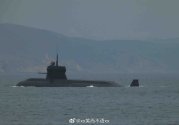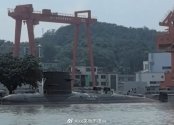Once again our resident super "smart sth" showing off the knowledge beyond comprehension.What is this nonsense?
As you were writing this did it ever occur to you to verify how submarines were able to use single towed arrays for locating targets for almost half a century, ever since USS Los Angeles entered service in 1976?
Take a sheet of paper. Draw a line with points along it - this is your linear array and your hydrophones. Now draw a source of sound and depict the soundwaves as concentric circles propagating from the source. As the circles reach the linear array there is a visible delay in when each hydrophone registers the signal. That delay allows the computer to calculate the position of the source.
As you will see with sufficiently long array there are only two cases where a linear array can't determine direction. Those two cases are axial symmetries - left or right and up or down - when the spherical wavefront propagates with the same speed toward each end of the array. There is no single mathematical solution. But there is a practical one.
To remain undefined the source would have to be exactly in the middle of the array and stay there. As soon as the source shifts its position relative to the array there is a delay on the hydrophones. As soon as the hydrophone position shifts relative to the source there's a delay. All the sub needs is to speed up or slow down a little or change direction.
Here your argument would likely be that it still doesn't resolve for location above or below the array. Except it does.
Sound propagates in water at 1,5km/s which is a delay of 0,1 millisecond per 15cm. Humans are capable of tracking tenths of a second with some precision and are aware of passage of time measured in the hundreths but are not able to track it. For a machine tenth of a millisecond is trivial. So all you need to do is move your array at an angle downwards or upwards. This requires a change of depth of as little as 50m at a slow pace to register some delay on an array that is hundreds of meters long. Similarly if the source changes depth that will register on an array.
Furthermore sound in water propagates with different speed depending on depth:

Those differences are minimal but sufficient for a machine calculating delays on a long towed array. The sub simply dives deeper and compares the results.
But ultimately the main reason why it is not a problem is the time that sonar requires for measurement. Sonar - and in particular passive sonar - is not precise, especially at extreme distances. Therefore detecting targets requires a completely different amount of time for a submarine than it does for an aircraft. Submarines detect and identify targets over hours, not seconds or minutes. You never see that in a movie because it would make for one hell of a boring movie.
It is extremely unlikely that two sources mirror each other's course for such long time at extreme distances - which is only when towed arrays are used. If it's a closer distance then the towed array is retracted regardless of whether the direction is known or not and the sub switches to using bow array or flank arrays. Those are planar and not linear and have no problems detecting position in space.
And that's entirely besides the modern engineering solution of having the array consist of clusters of hydrophones arranged asymmetrically and electronically gated so that received signal can be filtered depending on extremely minimal delays across 10-20 cm of relative distance between hydrophones. The filtering is cyclical turning the hydrophones off and on in sequence and that is enough to establish general direction.
And no, sonar doesn't work on the same principle as surround sound system in home cinema because the "r" in sonar stands for ranging. Sonar is short for "sound navigation and ranging". If you think surround sound has "ranging" you need to see a psychiatrist. Take a seat right next to the people who brought proof that 5g gave them covid.
Last edited:











